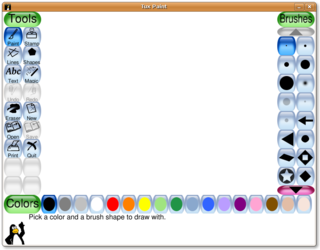
GNU Image Manipulation Program, commonly known by its acronym GIMP, is a free and open-source raster graphics editor used for image manipulation (retouching) and image editing, free-form drawing, transcoding between different image file formats, and more specialized tasks. It is extensible by means of plugins, and scriptable. It is not designed to be used for drawing, though some artists and creators have used it in this way.

The Graphics Interchange Format is a bitmap image format that was developed by a team at the online services provider CompuServe led by American computer scientist Steve Wilhite and released on June 15, 1987.

Portable Network Graphics is a raster-graphics file format that supports lossless data compression. PNG was developed as an improved, non-patented replacement for Graphics Interchange Format (GIF)—unofficially, the initials PNG stood for the recursive acronym "PNG's not GIF".

Wolfram Mathematica is a software system with built-in libraries for several areas of technical computing that allow machine learning, statistics, symbolic computation, data manipulation, network analysis, time series analysis, NLP, optimization, plotting functions and various types of data, implementation of algorithms, creation of user interfaces, and interfacing with programs written in other programming languages. It was conceived by Stephen Wolfram, and is developed by Wolfram Research of Champaign, Illinois. The Wolfram Language is the programming language used in Mathematica. Mathematica 1.0 was released on June 23, 1988 in Champaign, Illinois and Santa Clara, California.
OpenEXR is a high-dynamic range, multi-channel raster file format, released as an open standard along with a set of software tools created by Industrial Light & Magic (ILM), under a free software license similar to the BSD license.
Netpbm is an open-source package of graphics programs and a programming library. It is used mainly in the Unix world, where one can find it included in all major open-source operating system distributions, but also works on Microsoft Windows, macOS, and other operating systems.

Tux Paint is a free and open source raster graphics editor geared towards young children. The project was started in 2002 by Bill Kendrick who continues to maintain and improve it, with help from numerous volunteers. Tux Paint is seen by many as a free software alternative to Kid Pix, a similar proprietary educational software product.
Python Imaging Library is a free and open-source additional library for the Python programming language that adds support for opening, manipulating, and saving many different image file formats. It is available for Windows, Mac OS X and Linux. The latest version of PIL is 1.1.7, was released in September 2009 and supports Python 1.5.2–2.7.

LAMP is an acronym denoting one of the most common software stacks for the web's most popular applications. Its generic software stack model has largely interchangeable components.
An image file format is a file format for a digital image. There are many formats that can be used, such as JPEG, PNG, and GIF. Most formats up until 2022 were for storing 2D images, not 3D ones. The data stored in an image file format may be compressed or uncompressed. If the data is compressed, it may be done so using lossy compression or lossless compression. For graphic design applications, vector formats are often used. Some image file formats support transparency.
QFX is an image editing computer program developed by Ron Scott, a Texan photographer and software engineer. The first version was released in 1990. At the time of its release, QFX was one of the most feature-rich image editing applications available on the PC platform. It was the software of choice for digital artists and image postproduction studios in the times when 1024x768 truecolor graphics were a luxury, far before Photoshop could have been considered a serious professional tool. Its clean interface and clever workflow helped build a devoted user base, some of whom continue using it, despite QFXs being long ago eclipsed in features and users by Photoshop.
Developer's Image Library or DevIL, started by Denton Woods, is a cross-platform image library which aims to provide a common API for different image file formats. It consists of three parts: the main library (IL), the utility library (ILU) and the utility toolkit (ILUT), mirroring the corresponding parts of OpenGL.

ImageMagick, invoked from the command line as magick, is a free and open-source cross-platform software suite for displaying, creating, converting, modifying, and editing raster images. ImageMagick was created by John Cristy in 1987, it can read and write over 200 image file formats. It is widely used in open-source applications.
WebP is a raster graphics file format developed by Google intended as a replacement for JPEG, PNG, and GIF file formats. It supports both lossy and lossless compression, as well as animation and alpha transparency.
The following outline is provided as an overview of and topical guide to the Perl programming language:

mtPaint is a free and open-source raster graphics editor for creating icons, pixel art and for photo editing. It is available for Microsoft Windows and Linux operating systems.







